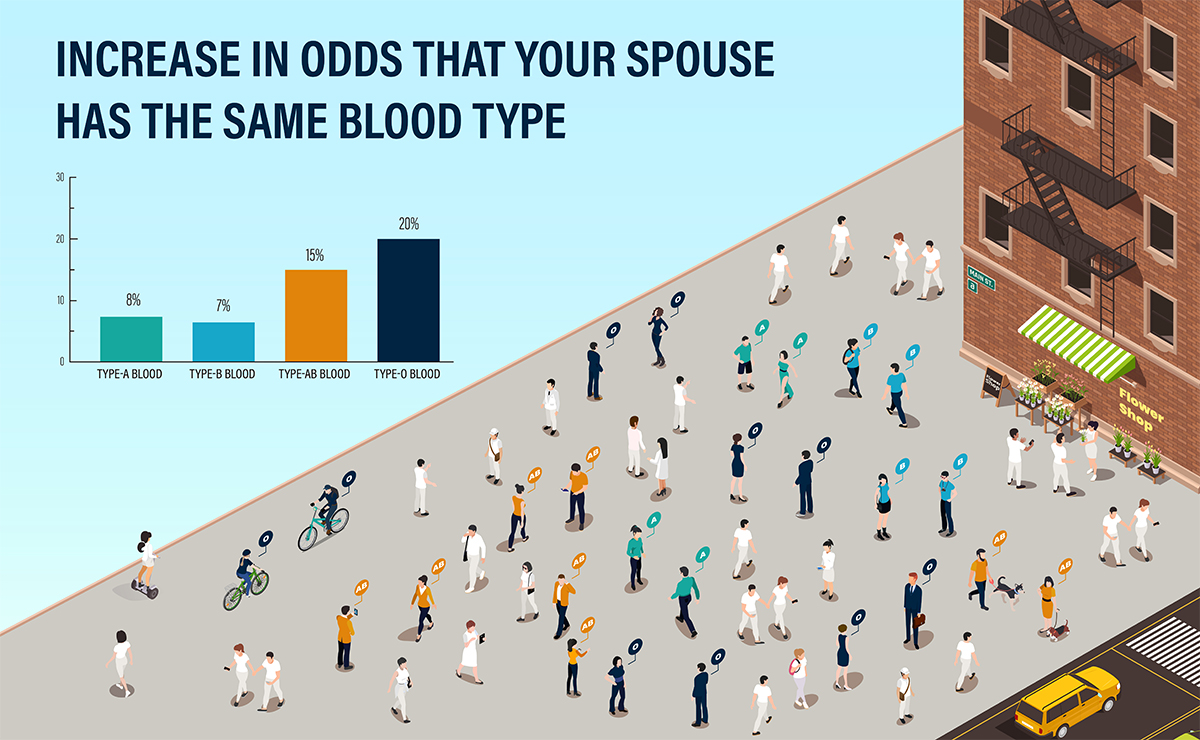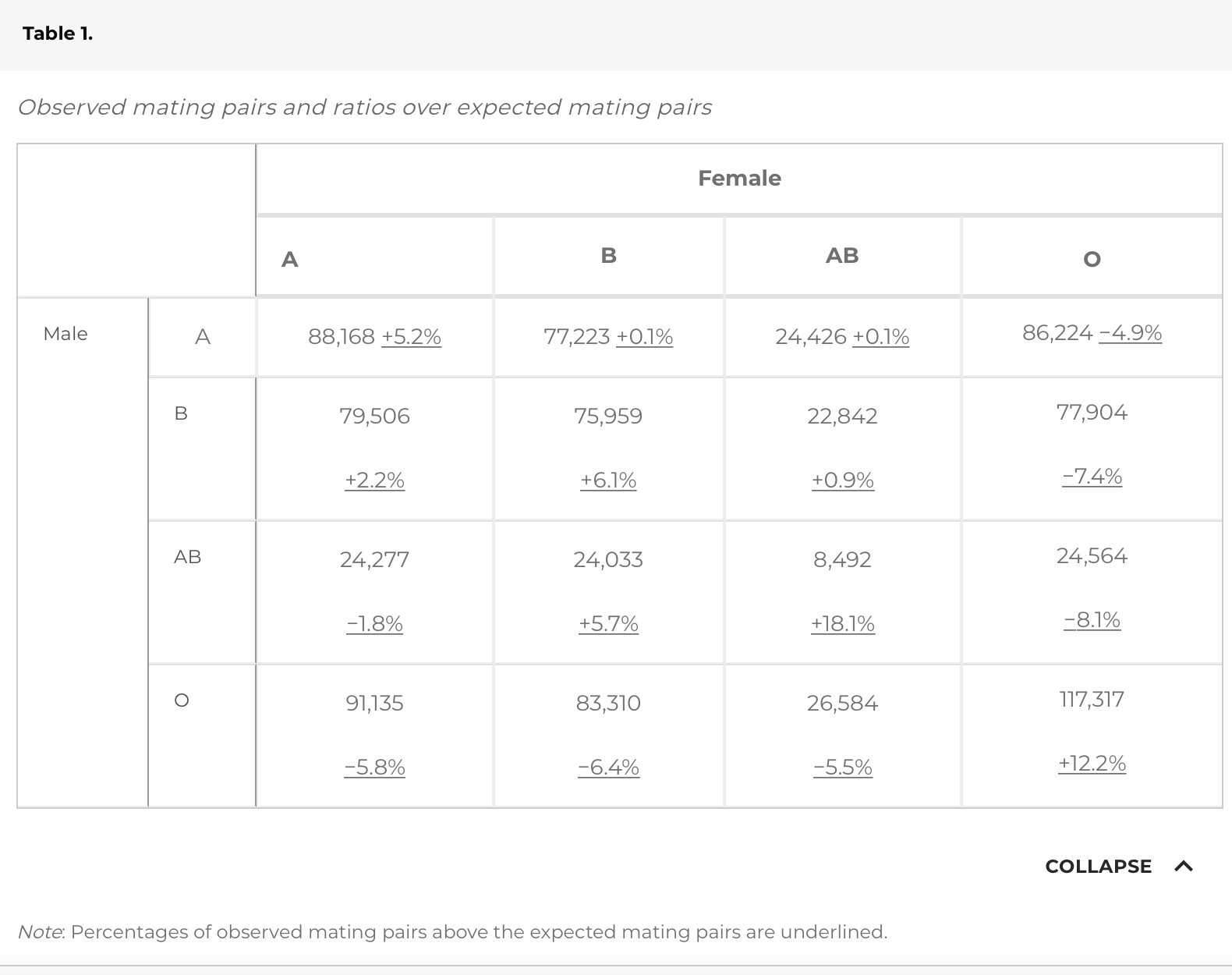Researchers have found that people of the same blood group have been more likely to pair up.
How we choose a spouse is probably not random. Studies already suggest that spouses often share phenotypes — a person’s observable traits, such as body mass index, weight, height and intelligence1-7. Now, a new examination of 931,964 couples in China suggests that romantic pairs are also more likely to share a blood type8.
The results were slightly different for each blood group, ranging from 5.2% to roughly 18.1% more likely than expected, if randomly selected, to share the same blood type. And the findings stood up even when multiple other population and locality factors were considered, notes one of the authors, Danxia Xie, from Tsinghua’s Institute of Economics. This, he says, suggests that it is not just opportunity, but partner choice that drives the pattern.

Tsinghua University authors (left to right) Ke Tang, Yao Hou and Danxia Xie have looked at the likelihood of spouses having the same blood type alongside colleagues from Beihang University in China and Michigan State University in the United States.
Sameness attracts
The sample population for the study was drawn from a group that participated in a free pre-pregnancy check-up targeting low-income married Chinese couples in urban areas and married couples in rural areas, all of whom planned to conceive in the next six months.
Another Tsinghua author, Ke Tang, also from the Institute of Economics, says: “One possible explanation is that blood type may act as a proxy for other phenotypes.” To look more deeply at this, the researchers examined phenotypic variables available in their data, such as education, job type, height, weight, pressure, and drinking habits, and found some statistical links to blood types. However, when the statisticians controlled for these variables, they still found strong evidence for separate blood-type mating tendencies.

Another potential reason for their finding, the authors suggested, might be the ease of living with a partner with the same blood type. Some studies indicate couples with similar phenotypes, such as alcohol consumption, may be more likely to remain in a relationship and thus make up a greater portion of couples in the sample, for example9-11. However, the researchers didn’t find strong evidence to support the argument that the similarity of spousal pairs’ blood types is associated with the length of marriage, and so ruled this out as a main driver.
Blood type, they say, is mostly explained by the distribution of blood types in the population of birthplace. Local population structure and the individual’s ethnicity also explain a considerable fraction, they note. Then, if a partner has a given blood type, the odds of their partner having the same blood type will increase by approximately 8% for those with type-A blood, 7% for those with type-B blood, 15% for those with type-AB blood, and 20% for those with type-O blood.
“These findings suggest that there is an unknown mechanism for this pattern,” says Tang. And this is a fascinating topic for future research, he says.
Disease consequences
Increases in pairings of those of the same blood type could have important genetic consequences, says Xie. Some blood types appear to have elevated disease risks, such as predispositions to dementia or cardiovascular disease. So, having a baby with someone with the same blood type can inflate their offspring’s chances of inheriting some traits, such as depression, which has been shown to be significantly higher in the type A and O blood types.
Blood type has, in fact, been linked with a variety of mental disorders: children with type O blood may be at a greater risk of attention-deficit disorder; people with A blood type may be more prone to obsessive-compulsive disorder, and children may be at a greater risk of attention-deficit disorder; and children with type B blood may have a lower risk of attention-deficit disorder. However, the associations are weak and many other factors may be more important in determining illness outcomes. Disorders such as these, without a clear pattern of inheritance in families and with multiple genetic links, may be affected in complex ways by reduced genetic diversity.
Nonethless, those with similar traits who choose to have children entrench those traits further, says Xie, by reducing the frequency of people that have two different alleles, one from each parent, of a particular gene or genes, and are thus able to pass on varying characteristics in their offspring.

It appears that in this sample, 5.2% of people in the A type blood group, 6.1% in the B type blood group, 18.1% of people in the AB type blood group and 12.2% of people in the O type blood group were more likely than expected, if randomly selected, to share the same blood type.
For this reason, procreation between non-similar phenotypes is often considered favorable, since it reduces the chances of producing less fit phenotypic extremes. Abundant research has shown that inbreeding may decrease the fitness of offspring12, as it increases the frequency of individuals who have two of the same alleles of a particular gene or genes, which enhances the risk of the unmasking of deleterious recessive alleles. This may be why the rarest AB blood group showed the most likelihood of choosing a spouse with the same blood type in this study.
Population modelling
Producing offspring with a person of the same blood type should also intensify trait divergence between the different blood groups, says Xie. And this will likely heighten natural selection directions13, since there are fewer individuals with two different alleles and the frequency of less fit homozygotes — people inheriting the same gene from each parent — could be reduced via natural selection14.
However, we should be cautious when extrapolating findings in Chinese populations to other populations, says Tang. Different contexts may encourage different outcomes. Other studies have shown, for example, that differences in immune function may encourage mate selection to give offspring a greater chance of survival.
Nonetheless, if blood type pairings are shown to be consistent across a population, it could have implications for modelling of future disease burden and should be explored further, say the researchers. “As far as we know, few studies focus on assortative mating on blood type,” Tang says. “It is therefore an open-ended result and there is endless potential to explore theories and look for evidence of mechanisms.”
References
1. Silventoinen, K., Kaprio, J., Lahelma, E., Viken, R. J. & Rose, R. J. Assortative mating by body height and BMI: Finnish twins and their spouses American Journal of Human Biology 15, 620–627 (2003)
2. Eaves, L. J. Assortative mating and intelligence: An analysis of pedigree data Heredity 30, 199–210 (1973)
3. Eaves, L. J. & Heath, A. C. Detection of the effects of asymmetric assortative mating Nature 289, 205–206 (1981)
4. Maes, H., Neale, M. & Eaves, L. Genetic and environmental factors in relative body weight and human adiposity Behavior Genetics 27, 325–351 (1997)
5. Zietsch, B. P., Verweij, K. J. H., Heath, A. C. & Martin, N. G. Variation in human mate choice: simultaneously investigating heritability, parental influence, sexual imprinting, and assortative mating The American Naturalist 177, 605–616 (2011)
6. Keller, M. C. et al. The genetic correlation between height and IQ: Shared genes or assortative mating? PLoS Genetics 9, e1003451 (2013)
7. Robinson, M. R., et al. Genetic evidence of assortative mating in humans Nature Human Behaviour 1, 1–13 (2017)
8. Hou, Y., Tang, K., Wang, J., Xie, D., Zhang, H. Assortative mating on blood type: Evidence from one million Chinese pregnancies PNAS 119 (51), e2209643119 (2022) doi: 10.1073/pnas.2209643119
9. Reynolds, C. A., Barlow, T., Pedersen, N. L. Alcohol, tobacco and caffeine use: Spouse similarity processes. Behavioural Genetics 36, 201 (2006)
10. Ask, H., Rognmo, K., Torvik, F.A., Røysamb, E., Tambs, K. Non-random mating and convergence over time for alcohol consumption, smoking, and exercise: The Nord-Trøndelag Health Study Behavioural Genetics 42, 354–365 (2012)
11. Howe, l. J. et al., Genetic evidence for assortative mating on alcohol consumption in the UK Biobank Nature Communications 10, 5039 (2019)
12. Pusey, A. & Wolf, M. Inbreeding avoidance in animals Trends in Ecology and Evolution 11, 201–206 (1996)
13. van Doorn, G. S., Edelaar, P., & Weissing, F. J. On the origin of species by natural and sexual selection Science 326, 1704–1707 (2009)
14. Lenormand, T. Gene flow and the limits to natural selection Trends in Ecology & Evolution 17, 183–189 (2002)
Editor: Guo Lili